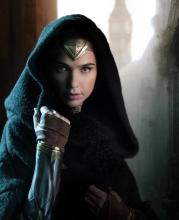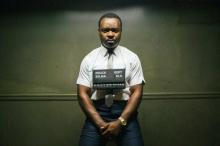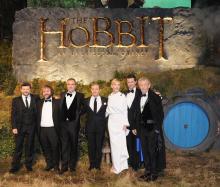movie review

Kenneth Branagh’s new big-screen adaptation of Christie’s novel is a diverting, gorgeous-looking film that struggles a little at showing the humbling effect that dilemma has on the great detective. However, it does a good job of portraying the pain at the center of this story, and how it metastasizes in its characters.

mother! is a disturbing portrait of God that says nothing good about God's followers. Immediately after watching the visitors kill her child, mother hears Him say that these people must be forgiven — that they didn’t mean to do it, that they only want to be close to Him. The Christian theory of redemption is supposedly one of forgiveness and sacrifice, predicated on Christ’s death and resurrection, but the death of this child doesn’t read at all triumphant. From the mother's point of view, the visitors were never supposed to be in the house in the first place — if they hadn’t intruded on her life, they wouldn’t need forgiveness for killing her child.

But really, the best performance in the film belongs to Nanjiani —no surprise, since it’s partly his own story. The affection he feels for his parents makes him afraid to upset them, but to really come into his own as a person, and as a comedian, he has to be honest with them about what he wants for his life.

Unfortunately, the script, by writer Colin Bateman often tends toward the bland, with the exception of a couple of pivotal scenes. Both Paisley and McGuinness were big, powerful personalities, with many facets to explore. The script, however, takes what could be a truly interesting exploration of two dynamic characters, and often reduces them to a pair of old men arguing in the back of a car. There are some standout moments where beliefs are challenged and moments of real emotional honesty are reached, but it takes some waiting to get there.

The new film Baby Driver is a movie that expresses joy through art, specifically music. The action film from director Edgar Wright connects the joy of listening to a favorite song to the way those musical rhythms color our everyday lives. At its best, the film is a celebration of joy in creativity that bleeds over into a joy in creation itself. It struggles, however, to turn that aesthetic delight into something of substance.

At first glance, the meaning behind this tagline for Wonder Woman feels obvious, it is the next step on the DC franchise road to November’s Justice League movie. But of course, there’s more to it than that. Wonder Woman marks a feminist milestone, too, one that feels like artistic justice: it’s the first major superhero movie to feature a female hero, and the first to use a female director, Patty Jenkins.

In Guardians of the Galaxy Vol. 2, out this weekend, Peter Quill (Chris Pratt), Gamora (Zoe Saldana), Drax (Dave Bautista), Rocket, (Bradley Cooper) and Groot, (Vin Diesel) are still learning lessons in openness and humility. But oddly, the film they’re in needs help maintaining emotional honesty, too. Where the first movie kept a fine balance of pathos and jokes, the second Guardians film is almost caustically cynical. The film is so preoccupied with witty banter that it misses nearly every opportunity to plumb the depths of the themes it presents, until finally pulling it together at the very end.

GOOD VIBRATIONS is a brilliant roof-raising musical from 2012 about making a difference in the world by being yourself. It’s the kind of film that makes you fall in love with life. And it was the last movie about which Ken Hanke and I wholeheartedly agreed.
Hanke, our local newspaper film critic in Asheville, N.C., recently passed away at the too-young age of 61. His byline identified him as “Cranky Hanke,” but he had a generous heart. He knew that good film criticism requires knowing three things, at least: something about cinema, something about how to write well, and something about life. The first of these comes naturally to people who watch enough good movies. The second is part gift to be channeled, part skill to be nurtured. As for the third, well, we all know something about life—the trick is whether or not we’re willing to let what we know of ourselves be known in our work.
Ken Hanke was a critic who believed his own opinions, but didn’t impose them on others. He understood film criticism as a conversation between movie and audience, in which being right isn’t as important as being authentic.
This kind of critical engagement is often ignored in favor of mere criticizing—reacting, not responding, snap judgments instead of considered reflection. “That’s one of the worst things I’ve ever seen” limits the possibility of conversation to discover more of what the movie might be inviting us to. I want to know why you think it’s the worst (or best). I want to be invited into a conversation about authenticity and what it is to live better in the light of what artists and other provocateurs are trying to tell us.

STANLEY KUBRICK’S Dr. Strangelove or: How I Learned to Stop Worrying and Love the Bomb was released in 1964, and it was echoed later that year by a film on a similar topic, Fail-Safe. Directed by Sidney Lumet, Fail-Safe imagined the idea of a nuclear explosion being unpreventable by the people supposed to be in charge of it. Strangelove is hilarious but chilling satire; Fail-Safe is just chilling. The central notion, that ethics can’t be trusted to machines, lingers today: George Clooney produced a live television version of Fail-Safe as recently as 2000.
A current version of the dilemma is brilliantly portrayed in Eye in the Sky. Cutting between four main locations (a British government committee room, a military control center in the English countryside, a Nevada drone piloting bunker, and the Kenyan house from where a suicide bomb attack may be launched), it’s like a relentless tennis match in which the crisscrossing ball is a matter of life and death.
Who decides who can be killed? If blowing up the house will prevent an attack that might kill 80 people, how much does it matter that a little girl selling bread nearby will probably die too? What is legal? Does “legal” mean “right”? Such questions have rarely been handled with such compelling dexterity in a movie. Eye in the Sky deserves comparison with Dr. Strangelove and Fail-Safe because it doesn’t offer easy answers, only difficult questions, and its seamless movement between locations fully immerses the audience inside the debate. But it transcends those earlier films because of the way it treats the characters that might be seen as “other.”

THE TEACHER Edwin Friedman believed that good leadership creates conditions for people to find tools to become emotionally mature. In other words, no matter what its stated goal (civil rights, community organizing, religious engagement), the most important purpose of leadership is to help us become more fully human.
Of course this is also true for artistic endeavors—stories that create emotional dependency in audience members are not offering good leadership, and they usually make for bad art too. We may like them, as they satisfy the surface-level desire for easily grasped narratives and quick resolution. But that’s the aesthetic equivalent of a cheap burger. Our deeper hunger is for stories that strive to tell the truth about life and its possibilities, that demand self-reflection, and that permit subtexts to breathe so we can fill in the gaps.
I saw three such films recently. Inside Out displays astonishing imagination, bringing us into the human psyche to figure out how we think. There’s genius in a story that gives the five core emotions personalities, wisdom in how it makes honest work of how people confront change, and a delightful bonus in the form of Bing Bong, a character with all the lovableness of Baloo the Bear and a purpose with which Carl Jung would be pleased. Inside Out offers no shortcuts to spiritual well-being. It’s film-as-therapy that’s as entertaining for kids as it is wise for adults (and vice versa).

IT’S THE 50TH anniversary of The Sound of Music. I never thought I’d write about it here, but someone recently offered me the kind of gentle admonishment that Maria might have given to the von Trapp children. Maria is usually right, and my friend is too. One of the wisest film critics I know, a man dedicated to contemplation and activism and who doesn’t shy away from the more challenging edges of cinema, still considers it his favorite film.

THE EXTRAORDINARY film Leviathan takes place in a tiny coastal town on the other side of the world, but it relates to all our dreams and fears.
A man is tormented by bureaucracy, as the authorities try to take his house. He has an unhealthy relationship with alcohol, and a very unhealthy one with his partner. He works on people’s cars, does favors for people who ask him, and tries to raise his son as best he can. And he’s caught between the wheels of historic oppression and emerging forms.
Leviathan, this year’s Russian nominee for the Best Foreign Language Film Oscar, is a work of uncommon cinematic bravery, for the people who made it take on the corruption of their current political masters. Vladimir Putin appears briefly, as a portrait looming over the office of the mayor trying to take our hero’s house. But the graft, selfishness, and cruelty of Putin’s imperial reign are palpably present in the mayor, who has been fighting the householder for years to get his property, for reasons that owe more than a little to the legacy of Soviet-era patriotic ideology. Communism has been replaced by a heady mix of nationalistic pride and elitism religion, whose boundaries are enforced with no mercy. Pussy Riot’s punk prayer gets a mention in a priest’s litany of things that are undermining Mother Russia. It’s the same old story, there and everywhere—keep the nation pure, confuse spirit and law, and wreck your own life by denying the glories of human diversity.

CLINT EASTWOOD has made films about the sorrow and repeating pointlessness of war, as seen through the eyes of both aggressor and aggressed-against, with empathic performances and unbearably moving impact. His American Sniper, about the most lethal sniper in U.S. military history, bloodied in Iraq and struggling at home, is not one of those films. At best it’s a valuable character study of a confused warrior, revealing the traumatic effect of his service. At worst it’s a jingoistic and xenophobic attempt to put varnish on a terrible national response to the horror of 9/11, a response that became a self-inflicted wound creating untold collateral damage.
A decade ago, Eastwood made Flags of Our Fathers and Letters from Iwo Jima, which saw World War II soldiers as propaganda fodder and had the moral imagination to show both sides as courageous and broken without denying the difference between attacker and defender. These films are respectful and thoughtful, but American Sniper is arguably a work born in vengeance. Its reception (becoming one of the biggest January box office weekends ever, and a quick right-wing favorite) is part of the failure to deal in an integrated way with the wounds of 9/11, or to even begin to face the reality of the war in Iraq: an imperial conquest using the cover of national trauma as a justification

FOR TWO YEARS in a row we have seen significant films about oppression and struggle nurture public consciousness. Selma and 12 Years a Slave invite us to reimagine iconic moments closer than we usually think, their protagonists more like us. Slavery had not been portrayed in such visceral fashion in a mainstream film before 12 Years. Before Selma, images of Martin Luther King Jr. had never quite transcended the almost superhuman projections that accrue from his martyrdom and decades of being co-opted by cultural mavens from Apple to Glenn Beck.
These films create new benchmarks for the mainstream depiction of black history, black struggle, and wider perceptions. But entertaining portrayals of inspiration contain a powerfully dangerous substance that needs to be handled with care. The cathartic tears shed at a film about other people’s suffering and heroism can also be a narcotic, implying that the work has been done. Think of all the talk about freedom struggles after Braveheart, or challenging the principalities and powers after The Matrix. The problem was, most of it was just that. Talk.
THIS PAST MOVIE year I’ve been delighted by, among other things, nonviolent resolutions, a guy talking in a car, an Irish priest trying to do the right thing, and a five-dimensional bookcase. Here’s my list of the 10 best films of 2014 (many more are worthy, but 10 are all that will fit).
10. Pride. A delightful and stirring celebration of marginalized people turning their woundedness into helping others, as LGBTQ activists support the Thatcher-era British coal miners’ strike.
9. The Lego Movie. This turned out to be both the most unpredictably fun and one of the wisest films of the year. A brilliant critique of consumerism and political tyranny, with an ending that inverts the myth of redemptive violence.

TOOTSIE, the 1982 Dustin Hoffman comedy in which a failing actor cross-dresses to win a part on a soap opera, is a lovely, problematic film (and just released in an excellent home edition from www.criterion.com). It’s controversial in some quarters for playing the idea of a man dressing as a woman for laughs: The joke is on any male-bodied person who challenges macho stereotypes. As when The Da Vinci Code attracted criticism for portraying a character with albinism as an insane assassin, like almost every other comparable movie has treated albinism, Tootsie represents a time when the extent of mainstream cinema’s engagement with what it thought constituted “trans” was to portray cross-dressing for laughs. But a cisgender straight character dressing up has little or nothing to do with the real stories of the “T” in LGBTQ.
Cinematic LGBTQ characters seem to evolve one step forward and a half back—beginning with their invisibility, then moving through psychopathy (the “evil queer” of Hitchcock’s Rope still shows up in The Lion King and The Avengers); martyrdom (Kiss of the Spiderwoman, Philadelphia, Brokeback Mountain); safe best friends (The Prince of Tides and My Best Friend’s Wedding); and eventually redemption (Milk, the wonderful recent Pride). The evolution continues: George Carlin’s gay best friend caricature in The Prince of Tides was in good faith, but would not pass muster today. We’re shaking off the idea that LGBTQ characters can only be suffering or sassy.

“God has to be busy with everyone else. And hopefully he will come into my life. I hope it happens. It’s going to break my heart if it don’t.”
So says Andrew, one of the three teenage subjects of the documentary Rich Hill, currently playing in theaters across the country. While film refrains from any sermonizing on poverty, or any direct call to action from its audience, it’s mighty hard for socially minded Christians to hear these words and not feel compelled to react. Tracy Droz Tragos and Andrew Droz Palermo’s documentary is an unflinching portrait of poverty in rural America, and its sympathetic portrayals give heartbreaking examples of neighbors in need.
The film follows a year in the lives of three boys: Andrew, Harley, and Appachey. They don’t know each other, but they have much in common. Besides living in the small town of Rich Hill, Mo., all three come from troubled families living well below the poverty line. Andrew is the most hopeful of the group. He’s got a family he loves, and a father who means well, but whose unrealistic dreams keep the family moving from place to place and dodging unpaid bills. Thirteen-year-old Appachey and 15-year-old Harley, however, come from darker situations. Harley is a victim of sexual abuse (his mother is in jail for attempting to kill the man responsible), while Appachey’s violent behavioral issues are simply too much to handle for his single mom, overwhelmed with his siblings and a dilapidated house filled to the rafters with junk.

This will be a night to remember!
On Monday, I had the opportunity of attending an advance screening of The Hobbit: An Unexpected Journey with a good childhood friend of mine. I sat in my favorite movie-watching seat (a few rows back and dead center), munching on free popcorn and drinks provided by a fellow moviegoer who wanted nothing more than to ensure that his entire row in the theater was happy and well-fed (not too unlike a Hobbit, really).
Just before the lights dimmed, I remember thinking how perfect the whole moment was. However, as exciting and as wonderful as those final moments of anticipation were, I also couldn’t help but wonder if I might be setting my expectations too high for the film that was about to come.
It turns out I needn’t have worried.